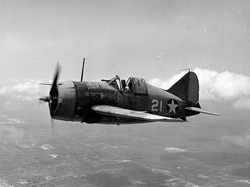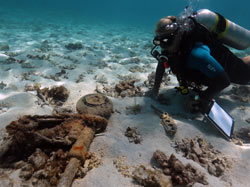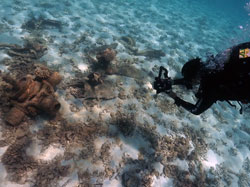Aircraft
A Sunken Warbird in Papahānaumokuākea: The Discovery and Investigation of a Brewster F2A-3 Buffalo in Midway Atoll Lagoon
One of the pivotal battles in American military history took place on Midway Atoll in the Northwestern Hawaiian Islands, and began the U.S. Navy's march across the Pacific that led to the defeat of Japan in World War II. Today Midway Atoll is a National Wildlife Refuge and part of Papahānaumokuākea Marine National Monument (PMNM), where wildlife abounds but relics from World War II remain.
The Battle of Midway, which took place on June 4-7, 1942, was largely a naval aviation battle engaging squadrons from American and Japanese carriers. Historical documents indicate numerous vessels and aircraft were lost, with an estimated 26 aircraft (both American and Japanese) down in the vicinity of Midway Atoll.
Recent archaeological expeditions to Midway and the surrounding islands have documented a number of sunken shipwreck sites but only three World War II era aircraft have been found to date, including this one. Although the waters of the central Pacific are very deep, researchers believe many of the planes crashed in relatively shallow water near the atoll. The aircraft and vessels from the battle constitute a significant record of the Navy's heroic efforts during the war.
In June of 2012, a team of NOAA divers from the Pacific Islands Fisheries Science Center Coral Reef Ecosystem Division were conducting marine debris surveys in PMNM and came across an exciting discovery – a sunken aircraft site in the Midway Atoll lagoon. The divers reported the find to PMNM maritime heritage staff, who conducted an initial survey of the site while at Midway Atoll later that summer as part of a larger Maritime Heritage expedition to PMNM.
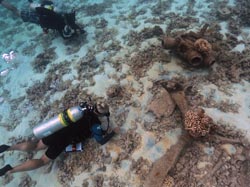
Maritime archaeologists Kelly Gleason and Bert Ho examine the propeller blades at the sunken aircraft site. Credit: Stephani Gordon/Open Boat Films
In July, the team of maritime archaeologists began to document and interpret the sunken aircraft site, collecting photographs and video, measured sketches and creating a site plan of the main concentration of artifacts. The team documented dozens of artifacts indicating an early American fighter aircraft, and believed that the evidence pointed to the wreckage of a Brewster F2A-3 Buffalo, one of the aircraft that defended Midway during the Japanese attack in 1942.
Based upon archival research, the team determined that the plane was one that crashed into the lagoon at Midway Atoll while trying to land at Eastern Island in a squall in February of 1942. The pilot of the plane, Lt. Col. Charles W. Somers, Jr., survived and went on to have a distinguished career as an aviator in the United States Marine Corps. He was awarded the Distinguished Flying Cross, became one of the first commanders of the famous VMF-214 Black Sheep Squadron, and participated in the Korean War before retiring as a Marine Corps Colonel in Pensacola, Florida.
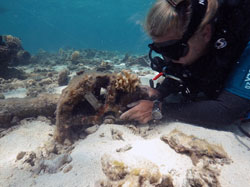
PMNM Maritime Heritage Coordinator Kelly Gleason examines landing gear from the sunken aircraft site, checking for identifying markings. Credit: Stephani Gordon/Open Boat Films
This exciting find is the third aircraft documented to date in Papahānaumokuākea Marine National Monument, and only the second at Midway Atoll. While archival records describe more than 70 potential aircraft losses within PMNM, this is the first aircraft discovered that was stationed at Midway Atoll to defend against the Japanese attack. This sunken aircraft is a window into a fascinating era of aviation history, and a reminder of the bravery and sacrifice of World War II veterans like Col. Somers.
The team involved in the July 2012 expedition that documented the site included PMNM Maritime Heritage Coordinator Kelly Gleason, Cathy Green (both with NOAA's Office of National Marine Sanctuaries), Bert Ho (National Park Service Submerged Resources Center) and Jason Raupp (Flinders University). Filmmaker Stephani Gordon (Open Boat Films) and biologist Susie Holst (NOAA Coral Reef Conservation Program) rounded out the multidisciplinary efforts.
Work to interpret this site and its role in the broader heritage of the Pacific is ongoing and research continues to provide more information about this aircraft and the compelling story of its pilot, Col. Charles W. Somers, Jr.
To see more photos, click here.
View a 3D Video of a Brewster F2A3 Buffalo at Midway Atoll. In August of 2014, scientists visited the site of the Brewster Buffalo in Midway lagoon to collect photos for a 3D model of the sunken aircraft. This 3D image allows you to see the scattered artifacts on the seafloor representing a rare, historic World War II era aircraft. Credit: John Burns
View another 3D Video of a Brewster F2A3 Buffalo at Midway Atoll. This link allows you to dive through the site and stop the video to take a closer look at interesting artifacts at the sunken aircraft site. Credit: John Burns
View New York Times article here.
View Honolulu Star Advertiser article here (you may need to be a subscriber to view subscriber content).
